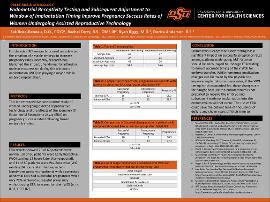| dc.contributor.author | Rose-Reneau, Zak | |
| dc.contributor.author | Terry, Rachel | |
| dc.contributor.author | Riggs, Ryan | |
| dc.contributor.author | Anderson, Derica | |
| dc.date.accessioned | 2023-11-02T20:45:55Z | |
| dc.date.available | 2023-11-02T20:45:55Z | |
| dc.date.issued | 2023-02-17 | |
| dc.identifier | ouhd_Reneau_endometrialreceptivitytesting_2023 | |
| dc.identifier.citation | Rose-Reneau, Z., Terry, R., Riggs, R., and Anderson, D. (2023, February 17). Endometrial receptivity testing and subsequent adjustment to window of implantation timing improve pregnancy success rates of women undergoing assisted reproductive technology. Poster presented at Research Week, Oklahoma State University Center for Health Sciences, Tulsa, Ok. | |
| dc.identifier.uri | https://hdl.handle.net/11244/339902 | |
| dc.description.abstract | Introduction: For decades, REI research focused solely on the creation of a viable embryo to increase pregnancy rates. Recently, research has identified the impact of endometrial adhesion molecule expression during the Window of Implantation (WOI) as playing a major role in embryo implantation. | |
| dc.description.abstract | Methods: This is a retrospective case-control study of women undergoing Assisted Reproductive Technology (ART) and the effects of the Igenomix © Endometrial Receptivity Assay (ERA) on pregnancy success rates following frozen embryo transfer. | |
| dc.description.abstract | Results: ERA results showed 29 of 60 patients were normal, 20 of 60 patients were Early Receptive (WOI existing 12 hours later than expected), and 11 of 60 patients were Pre-Receptive (WOI existing 24 hours later than expected). Ninety-one percent of patients with a corrected abnormal ERA had successful pregnancies while only 72% achieved successful pregnancy without using ERA to assess for their WOI (p = < 0.01, OR 3.82). | |
| dc.description.abstract | Conclusions: Endometrial Receptivity Assay testing has a significant impact on successful pregnancy rates among patients undergoing ART. Women should be encouraged to undergo ERA testing to ensure accurate timing of their WOI for embryo transfer. While numerous medication changes can be made by the physician to improve implantation success rates if the WOI timing is not accounted for, those changes are for naught because the endometrium is not prepared to receive the embryo, and subsequent embryo implantation into the endometrium will not occur. The use of ERA could save the patient tens-of-thousands of dollars and shave years off their time to achieve successful pregnancies. | |
| dc.format | application/pdf | |
| dc.language | en_US | |
| dc.publisher | Oklahoma State University Center for Health Sciences | |
| dc.rights | The author(s) retain the copyright or have the right to deposit the item giving the Oklahoma State University Library a limited, non-exclusive right to share this material in its institutional repository. Contact Digital Resources and Discovery Services at lib-dls@okstate.edu or 405-744-9161 for the permission policy on the use, reproduction or distribution of this material. | |
| dc.title | Endometrial receptivity testing and subsequent adjustment to window of implantation timing improve pregnancy success rates of women undergoing assisted reproductive technology | |
| osu.filename | ouhd_Reneau_endometrialreceptivitytesting_2023.pdf | |
| dc.type.genre | Presentation | |
| dc.type.material | Text | |
| dc.subject.keywords | assisted reproductive technology | |
| dc.subject.keywords | endometrial receptivity assay | |
| dc.subject.keywords | implantation | |
| dc.subject.keywords | pregnancy | |
| dc.subject.keywords | reproductive endocrinology | |
